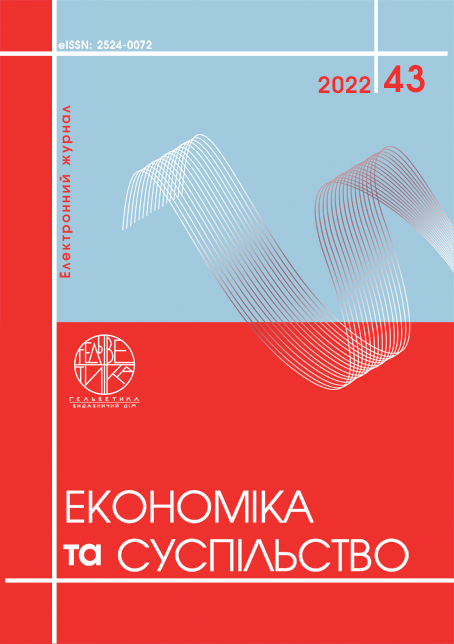WAYS TO IMPROVE LEADERSHIP AND INNOVATION DEVELOPMENT DURING THE WAR AND IN THE POST-WAR PERIOD
Abstract
The growing importance of innovations for the economic recovery as well as the low innovativeness level of the Ukrainian economy, actualize the need for managers-leaders, as individuals who are the drivers of innovative activity in the country, because they are able to generate innovative ideas and, even in crisis conditions, successfully adapt subordinates to rapidly changing situations. In this regard, the purpose of the article is to determine ways to stimulate leadership and innovation in Ukraine during the war and post-war times. Based on a logical analysis and generalization of world experience, this study proposes: firstly, to support and further develop the existing business in the country; secondly, to build the potential of local businesses through the formation and realization of the entrepreneurial potential of young people, who will generate innovative ideas in the near future. According to the analysis of international experience, small and medium-sized enterprises (SMEs) plays a key role in the growth of the economy on post-conflict territories. Moreover, an important element of effective support and reconstruction of business in the country in conditions of force majeure (war, pandemic, etc.) is the expansion of access for SMEs to capital and to educational and consulting support programs. In order to increase the number of managers-leaders in Ukraine during the war and post-war times, it is proposed to promote the formation and realization of the entrepreneurial potential of young people, in particular by improving the quality and practical orientation of Ukrainian education. This requires, among other things, improvement of curricula and programs taking into account new business challenges; establishment of partnership relations between universities and businesses; increasing personnel mobility between universities and enterprises, etc. The obtained results may be useful to civil servants of the Committee of the Verkhovna Rada of Ukraine on Education, Science and Innovation and the Ministry of Education and Science of Ukraine.
References
Череповський К. Японське диво. Як це було? НВ. URL: https://nv.ua/opinion/japonskoe-chudo-kak-eto-bylo-502710.html
Cameron, G. (1996). Innovation and economic growth. Centre for economic performance. Discussion paper No. 277. URL: https://eprints.lse.ac.uk/20685/1/Innovation_and_Economic_Growth.pdf
Jones, C. (2005). Growth and Ideas. Chapter 16 in Aghion P and S Durlauf (eds.) Handbook of Economic Growth 1B, Elsevier BV.
Amabile, T.M. & Khaire, M. (2008). Creativity and the Role of the Leader. Harvard Business Review. URL: https://hbr.org/2008/10/creativity-and-the-role-of-the-leader
Kozioł-Nadolna, K. (2020). The Role of a Leader in Stimulating Innovation in an Organization. URL: https://www.researchgate.net/publication/343779240_The_Role_of_a_Leader_in_Stimulating_Innovation_in_an_Organization
Українська мрія: як відбудовувати державу після війни? (2022). Ключові тези з Весняного ділового форуму у Львові. Forbes. URL: https://forbes.ua/news/ukrainska-mriya-yak-vidbudovuvati-derzhavu-pislya-viyni-klyuchovi-tezi-z-vesnyanogo-dilovogo-forumu-u-lvovi-25052022-6207
Arum, R. and W. Mueller (eds.) (2004). The Reemergence of Self-employment: A Comparative Study of Self-employment Dynamics and Social Inequality, Princeton NJ, Princeton University Press.
Colombier, N. and D. Masclet (2008). Intergenerational correlation in self-employment: some further evidence from French ECHP data, Small Business Economics, Vol. 30: 423–437.
Dunn, T. and D. Holtz-Eakin (2000). Financial capital, human capital and the transition to selfemployment: evidence from intergenerational links, Journal of Labor Economics, Vol. 18: 282–305.
Lindquist, M. J., Sol, J., & Van Praag, M. (2015). Why Do Entrepreneurial Parents Have Entrepreneurial Children? Journal of Labor Economics, 33(2), 269–296. DOI: https://doi.org/10.1086/678493
Sørensen, J. B. (2007). Closure and Exposure: Mechanisms in the Intergenerational Transmission of Self-employment. Research in the Sociology of Organizations, Vol. 25: 83–124.
Aflalo E. (2021) Study confirms growing up with a silver spoon increases entrepreneurial tendencies. CTech. Available at: https://www.calcalistech.com/ctech/articles/0,7340,L-3889995,00.html
Variable Report – Tables. Joint EVS/WVS 2017-2021. Dataset. Updated tables as of July 2021 (v.2) Related to the Joint EVS/WVS, Version 2.0.0GESIS: doi: 10.4232/1.13737 WVSA: doi: 10.14281/18241.14. – 551 p. – P. 455–456.
Variable Report – Tables. Joint EVS/WVS 2017-2021. Dataset. Updated tables as of July 2021 (v.2) Related to the Joint EVS/WVS, Version 2.0.0GESIS: doi: 10.4232/1.13737 WVSA: doi: 10.14281/18241.14. – 551 p. – P. 473–474.
Cherepovskyi, K. (2017). Yaponske dyvo. Yak tse bulo? NV. Available at: https://nv.ua/opinion/japonskoe-chudo-kak-eto-bylo-502710.html [in Ukrainian].
Cameron, G. (1996). Innovation and economic growth. Centre for economic performance. Discussion paper No. 277. Available at: https://eprints.lse.ac.uk/20685/1/Innovation_and_Economic_Growth.pdf
Jones, C (2005). Growth and Ideas. Chapter 16 in Aghion P and S Durlauf (eds.) Handbook of Economic Growth 1B, Elsevier BV.
Amabile, T.M. & Khaire, M. (2008). Creativity and the Role of the Leader. Harvard Business Review. Available at: https://hbr.org/2008/10/creativity-and-the-role-of-the-leader
Kozioł-Nadolna, K. (2020). The Role of a Leader in Stimulating Innovation in an Organization. Available at: https://www.researchgate.net/publication/343779240_The_Role_of_a_Leader_in_Stimulating_Innovation_in_an_Organization
Ukrainska mriia: yak vidbudovuvaty derzhavu pislia viiny? (2022). Kliuchovi tezy z Vesnianoho dilovoho forumu u Lvovi. Forbes. Available at: https://forbes.ua/news/ukrainska-mriya-yak-vidbudovuvati-derzhavu-pislya-viyni-klyuchovi-tezi-z-vesnyanogo-dilovogo-forumu-u-lvovi-25052022-6207 [in Ukrainian].
Arum, R. and W. Mueller (eds.) (2004). The Reemergence of Self-employment: A Comparative Study of Self-employment Dynamics and Social Inequality, Princeton NJ, Princeton University Press.
Colombier, N. and D. Masclet (2008). Intergenerational correlation in self-employment: some further evidence from French ECHP data, Small Business Economics, Vol. 30: 423–437.
Dunn, T. and D. Holtz-Eakin (2000). Financial capital, human capital and the transition to selfemployment: evidence from intergenerational links, Journal of Labor Economics, Vol. 18: 282–305.
Lindquist, M. J., Sol, J., & Van Praag, M. (2015). Why Do Entrepreneurial Parents Have Entrepreneurial Children? Journal of Labor Economics, 33(2), 269-296. DOI: https://doi.org/10.1086/678493
Sørensen, J. B. (2007). Closure and Exposure: Mechanisms in the Intergenerational Transmission of Self-employment. Research in the Sociology of Organizations, Vol. 25: 83–124.
Aflalo E. (2021) Study confirms growing up with a silver spoon increases entrepreneurial tendencies. CTech. Available at: https://www.calcalistech.com/ctech/articles/0,7340,L-3889995,00.html
Variable Report – Tables. Joint EVS/WVS 2017-2021. Dataset. Updated tables as of July 2021 (v.2) Related to the Joint EVS/WVS, Version 2.0.0GESIS: doi: 10.4232/1.13737 WVSA: doi: 10.14281/18241.14. – 551 p. – P. 455–456.
Variable Report – Tables. Joint EVS/WVS 2017-2021. Dataset. Updated tables as of July 2021 (v.2) Related to the Joint EVS/WVS, Version 2.0.0GESIS: doi: 10.4232/1.13737 WVSA: doi: 10.14281/18241.14. – 551 p. – P. 473–474.


